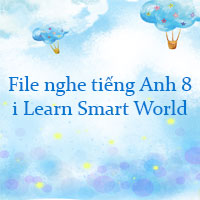Giáo án tiếng Anh lớp 8 Tuần 22 sách mới
Giáo án tiếng Anh lớp 8 chương trình mới Tuần 22
Giáo án Tuần 22 lớp 8 môn tiếng Anh dưới đây nằm trong tài liệu Giáo án môn lớp 8 môn Tiếng Anh theo tuần do VnDoc.com sưu tầm và đăng tải. Nội dung giáo án được biên soạn một cách kỹ lưỡng giúp quý thầy cô soạn bài nhanh và hiệu quả hơn.
Period: 61 Date of planning: ……/……/……
Date of teaching: ……/……/……
UNIT 7: POLLUTION
Lesson 7: Looking back & project
I. Objectives:
1. Knowledge: By the end of the lesson ,students will be able to :
- Review the lexical items related to the topic: pollution.
- Review the grammar of the unit: Conditional sentence I and II.
- Make questions and answers about the topic.
2. Skills: listening, writing
3. Attitude: Ss must have good attitude towards doing exercises
4. Competencies: Self-assessment
II. Main languages:
1. Vocabulary: Words related to the topic
2. Grammar:
III. Teaching aid: lesson plan , visual pictures
IV. Procedures
Teacher’s activities | Ss’ activities | Contents | ||||||||||||
Warm – up.( 5’): Play: Lucky number - T explains the rule. - T gives the explanation and ss say the word. Presentation(15’) Pre-teach vocab: 1. Complete the sentences with the correct form of the words in brackets. Check Ss’ answers. 2. Write types of pollution in the word web. Ask some Ss to write their answers on the board. Confirm the correct answers. 3.Rewrite the sentences, using the words in brackets. Have two Ss write sentences on the board. T and other Ss give comments. This activity may be conducted as a game if T wants to lighten the atmosphere. Pick the sentences of three quickest pairs. Announce the winning pair with the most correct sentences. Practice (15’) 4. Put the verbs in brackets into the correct forms. Check their answers 5. Complete the sentences, using your own ideas. Remind them to identify whether the sentence is a conditional sentence type 1 or type 2. Call some Ss to share their sentences. Accept all the sentences if they make sense. Further practice (7’) 6. Work in groups. Discuss what your would do or say in each situation. Ask Ss to read the example. Move around the class to listen to their ideas. PROJECT What would you do if…??? Ask Ss to read the information about the project. Ask if Ss still remember what a collage is. They made a collage in Grade 7. If they do not remember clearly, tell them that a collage is a picture made by sticking photographs, pictures or drawings onto a surface. Remind Ss that they should use conditional sentences type 2 to give the presentation. Answer Ss’ questions if there are any. Remember to have Ss present their collage in the next lesson and vote for the best. Homework(3’): Ask students to complete the project. Prepare unit 8 lesson 1 | - Ss play in 2 big groups. Ss do this activity individually then compare their answers with a partner. Ss do this exercise individually. Ss write the sentences using the words in brackets. Ss compare their sentences with a partner. Ss write the sentences in pairs. Ss do this exercise individually and then share the answers with a classmate. Ss complete the sentences individually using their own ideas. Ss work in groups to discuss what they would do or say in each situation. Ss may not need to discuss all the situations. Two or three groups may discuss the same situation. Ss complete the project. Ss work in groups to do the project following the instructions in the book. | Lucky number
*Vocabulary: + algal bloom + cooling tower + power station Key: 1. pollution 2. contaminated 3. death 4. Poisonous 5. pollution Key: 1. radioactive pollution 2. noise pollution 3. visual pollution 4. thermal pollution 5. water pollution 6. land/ soil pollution 7. light pollution 8. air pollution. Key: 1. The residents of the street cannot sleep because of the loud noise from the music club. 2. Vy had stomachache since she eat a big dinner. 3. The road in from of my house was flooded due to the heavy rain. 4. His mother is unhappy because his room is untidy. 5. Too much carbon dioxide (CO2) in the atmosphere causes global warming. Key: 1. Won’t be; don’t take 2. Continue; will be 3. Were/ was; would wear 4. do; will see 5. Woud…travel; didn’t have 6. Wouldn’t be; didn’t take care |
DESCRIPTION OF UNIT 8
By the end of the unit, Ss will be able to:
-Review present tense
-Use present simple for future
-Pronounce the words ending in -ese and -ee
-Read for special information about an English speaking country
-Listen for specific information about a day trip to a town in an English speaking country
-Talk about an English speaking country
-Describe a schedule for a visit or a tour
Period: 62 Date of planning: ……/……/……
Date of teaching: ……/……/……
UNIT 8: English SPEAKING COUNTRY
Lesson 1: Getting Started – How’s your summer camp?
I. Objectives:
1. Knowledge: By the end of the lesson ,students will be able to :
- introduce people and places of interest in English speaking countries
2. Skills: Drill listening ,speaking ,reading and writing mainly.
3. Attitude: Ss must have good attitude towards the co-operation
4. Competencies: Presenting opinions and giving comments to others’ opinions
II. Main languages:
1. Vocabulary: lexical items related to the topic “ Englishspeaking countries”
2. Grammar: Review: use the present simple to talk about future activities
III. Teaching aid: lesson plan, visual pictures
IV. Procedures
Teacher’s activities | Ss’ activities | Contents |
Warm – up.( 5’) - Prepare some photos or magazine cut-outs of some famous monuments or items from English speaking countries. Show them to Ss and have them guess what country each monument/item is from. Ask Ss if they know of a common thing among these countries. It’s the language: English. Presentation (10’) Pre-teach vocab: Write the title “English speaking countries” on the board. Ask Ss to call out names of English speaking countries and their main cities. Then ask Ss to share any interesting facts they know about these places.Ask Ss to open their books and look at the picture. Ask them some questions: 1. Ask Ss to look at the title of the conversation and the picture. Ask them some questions: * Where are the children? * What do you think they are doing? Ss answer the questions as a class. Play the recording and have Ss follow along. Practice (22’) 1a Find a word or an expression from the conversation which you use when you…. . Guide Ss to look at the beginning of a reply/ a sentence for the answers. Allow Ss to share answers. Check their answers. Ask Ss: Do you know any other expressions which have the same meaning? b. Read the conversation again and answer the questions. Play the recording again without letting Ss read along. Ask ss to try to answer as many questions as possible. Ss then read the conversation again to check their answers. Have some Ss read out their answers. Correct the answers as a class. 2. Complete the sentences with the words or phrases from the box. Ask Ss to underline these words/ phrases in the conversation and make sure they understand their meanings. Ss work independently to complete the sentences. Have them share their answers in pairs. Then elicit the answers from the whole class. Note: Your first language is often known as your mother tongue, and your second language may refer to a language used as an official language in your country, like English in Malaysia, Singapore, India or it could simply mean the foreign language you learn at school as part of the curriculum. 3. Put the names of the countries under their flags. T checks. Further practice (5’) 4. GAME: Where are they? From groups of five or six. The first group to find all the countries wins. If possible, prepare a black and white world map on A3 paper or quickly draw a world map on the board. Ask one student from the winning group to go to the board and mark the six countries so that other groups can see and check. Homework(3’): Prepare for unit 8 lesson 2 | +whole class. Whole class Ss answer the questions as a class. Ss work independently Ss read the conversation again to answer the questions. Ss exchange their answers with a classmate Ss work independently to complete the sentences then share their answers in pairs. Ss work in pairs/ groups to match the flags with the countries. Ss work in groups of five or six | Warm – up.( 5’): Guessing *Vocabulary 1.Awesome 2. Any of the following: Absolutely/ Right. 3. It’s hard to say 4. Perhaps + accent (n) Key: 1. Awesome, just awesome 2. Any of the following: Absolutely/ Right.3. It’s hard to say 4. Perhaps Key: 1. He’s at an international summer camp (in Singapore). 2. They come from different countries/ from all over the world. 3. He has made new friends, visited places, (and taken part in different activities.) 4. Because he uses English every day with people from different countries. 5. Two boys from Australia and a girl from the USA. 6. After July 15th. * Grammar: Review: use the present simple to talk about future activities Key: 1. summer camp 2. native English speaking countries 3. native speakers 4. the USA 5. accents 6. official language Key: 1. the USA 2. The United Kingdom 3. Singapore 4. Australia 5. Canada 6. New Zealand Note: The UK, or the United Kingdom = Great Britain + Northern Ireland Great Britain/ Britain = England + Scotland + Wales The USA = The United States of American. It is also known as the US, or the united States, or even just the States. In Canada, there are two official languages: English and French. |
Period: 63 Date of planning: ……/……/……
Date of teaching: ……/……/……
UNIT 8: English SPEAKING COUNTRY
Lesson 2: A closer look 1
I. Objectives:
1. Knowledge: By the end of the lesson ,students will be able to :
- Practice the vocabulary and pronunciation of the unit.
2. Skills: Speaking, Listening and writing.
3. Attitude: Ss must have good attitude towards the co-operation
4. Competencies: Presenting opinions and giving comments to others’ opinions
II. Main languages:
1. Vocabulary: words related to the topic: Englishspeaking countries
2. Grammar: Review: use the present simple to talk about future activities
3. Pronunciation: Stress. In words ending in – ese and –ee.
III. Teaching aid: lesson plan , visual pictures
IV. Procedures
Teacher’s activities | Ss’ activities | Contents |
Warm – up.( 5’) - Ask Ss to call out the names of some English speaking countries they learnt in the previous lesson. Tell them that in this lesson they are going to learn different forms of some words as well as some words/ phrases related to the topic. Pre-speaking(15’) 1. Write the names for the people who belong to these places. Then listen and repeat the words. Ask Ss to work individually. Then allow them to share their answers with a partner. Play the recording for Ss to check their answers. Ss listen and repeat. (Point out the change of stress from ‘Canada to Ca’nadian). 2. Change the words into a noun(N, an adjective (A) or verb (V). Ask Ss work individually or in pair. Check the answers as a class. If time allows, have two Ss write their answers on the board and then confirm the correct answers. While-speaking (17’) 3. Use the words in the box to complete the sentences. Firstly T asks Ss to read each sentence and decide what the part of speech is for each word to be filled in the blank. For example, the word for the blank in sentence 1 is a noun. They then complete the sentences. Confirm the correct answers as a class. 4. Match the words/ phrases with the pictures. T has Ss look at the pictures. Ask them what they see in each of them. Allow them then to work individually to match the words/ phrases to the pictures. Check the answers as a class by asking Ss in which countries, from the list in 1, they might see these things or ask them to give an example of these things. Post-speaking (5’) Pronunciation Stress in words ending in-ese and - ee 5. Listen and repeat the words. Ask Ss to listen and repeat. Then have Ss say the words individually. With stronger groups, have Ss mark the stress in the words first and say the words aloud before they listen to the recording. Then play the recording for them to listen, check and repeat. 6. Mark the stress in the underlined words. Then listen and repeat the sentences. T puts the underlined words on the board. Have volunteer Ss come and mark the stress in the words first. Ask for a show of hands from the rest of the class if they think the stress is correct or not. Then play the recording. Ss listen, check and say the sentences. Have Ss correct the stress on the board if necessary. Call on some Ss to say the sentences individually. Homework(3’): Prepare for unit 8 lesson 3 | +whole class. Ss work individually Ss work individually or in pair. Ss work independently Ss work independently Ss say the words individually. Ss work in pairs | Warm – up.( 5’): Review Key: 1. the Americans 2. The English 3. The Scottish/ the Scots 4. The Welsh 5. the Irish 6. The Canadians 7. The Australians 8. The New Zelanders Key: 1. N = history 2. V = symbolize 3. A = legendary 4. N = icon 5. A = spectacular 6. N = festival 7. A = scenic 8. V = attract Key: 1. icon 2. symbolizes 3. scenic 4. unique 5. attracts Key: 1. castle 2. loch 3. parade 4. monument 5. state 6. cattle station Key: - ese - ee Audio script: Canto’nese employ’ee Taiwa’nese adop’tee - ese: Contonese, Taiwanese, Japanese, Portuguese Jaerviepa’nese addre’ssee - ee: employee, adoptee, addressee, interviewee Portu’guese interview’ee Key: 1. Chi’nese 2. refu’gee 3. trai’nee 4. Japa’nese 5. guaran’tee |
Trên đây là Giáo án tuần 22 môn tiếng Anh 8 mới.
Xem thêm giáo án tiếng Anh 8 cả năm tại: Giáo án tiếng Anh 8 chương trình mới cả năm. Mời bạn đọc tham khảo thêm nhiều tài liệu ôn tập Tiếng Anh 8 cả năm khác như: Để học tốt Tiếng Anh 8, Trắc nghiệm trực tuyến Tiếng Anh 8, Đề thi học kì 1 lớp 8, Đề thi học kì 2 lớp 8,.... được cập nhật liên tục trên VnDoc.com.










